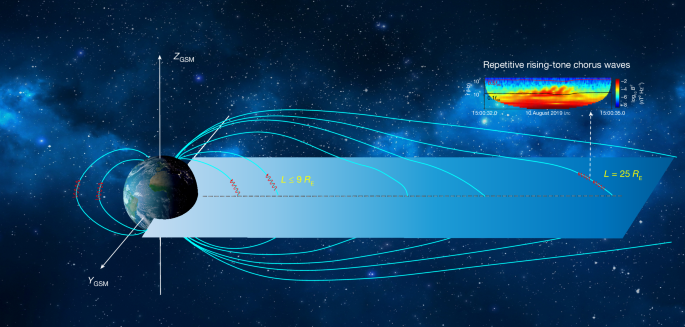Wave dispersion relation
The wave dispersion relation is resolved based on Ampere’s law40, which suggests that the relation between the wavevector and the wave magnetic field is
$$\boldsymbol\mu _\bfJ=i\bfk\times \bfB,$$
(1)
where J, k, B and μ0 are the wave current density, wavevector, wave magnetic field and magnetic permeability in empty space, respectively. Based on this equation, we can directly calculate the magnitude and direction of k from single-spacecraft or multi-spacecraft measurements of the current and magnetic field, without using electric field data or assuming any dispersion relation for the observed waves. We have four-point, high-cadence measurements provided by MMS, which are more applicable in resolving the space–time ambiguity of the waves.
Instability analysis
To investigate the generation of a chorus, we solved the kinetic dispersion relations of electromagnetic waves using two different methods: the widely used WHAMP (Waves in Homogeneous Anisotropic Multicomponent Magnetized Plasma) and the recently developed BO41. The main difference between these two methods is that WHAMP requires an initial guess for the wave dispersion relation, whereas BO can give all possible solutions without any initial guesses. The local plasma parameters in association with the observed wave emissions were used as inputs: \(| B| \approx 5\,\rmnT\), \(n_\rme\approx 0.1\,\rmcm^-3\), \(T_\rme\approx \text5,000\,\rmeV\), \(T_\rme,\perp /T_\rme,\parallel \approx 1.2\) and \(f_\rmpe/f_\rmce\approx 25\). The two methods yielded similar positive growth rates, suggesting that the local conditions are indeed unstable to parallel-propagating whistle-mode waves.
Electric field and current density
Using multipoint, high-cadence measurements provided by the MMS mission, we investigated the energy exchange inside the chorus waves with Poynting’s law:
$$\frac\rm\partial \bfE_\rmEM\rm\partial t=-\,\bfE\cdot \bfJ-\boldsymbol\nabla \cdot \bfS,$$
(2)
$$\bfS=\bfE\times \bfB/\boldsymbol\mu _,$$
(3)
where EEM, E, J, S, B and μ0 represent the electromagnetic field energy density, electric field, current density, Poynting flux density, magnetic field and magnetic permeability in empty space, respectively. We decomposed the electric fields and currents into mean and fluctuating values with band-pass filtering (10–40 Hz in the present case):
$$\bfE\cdot \bfJ=(\langle \bfE\rangle +\rm\delta \bfE)\cdot (\langle \,\bfJ\rangle +\rm\delta \bfJ)=\langle \bfE\rangle \cdot \langle \,\bfJ\rangle +\rm\delta \bfE\cdot \rm\delta \bfJ,$$
(4)
where \(\langle \bfE\rangle \), \(\rm\delta \bfE\), \(\langle \,\bfJ\rangle \) and \(\rm\delta \bfJ\) denote the mean electric field, fluctuating electric field, mean current density and fluctuating current density, respectively. The first term on the right-hand side of equation (4) quantifies the laminar energy transfer, which is related to the large-scale motion of particles (at and above the ion inertial scale) and, hence, was not studied here. The second term evaluates the turbulent energy transfer (note that the \(\langle \bfE\rangle \cdot \rm\delta \bfJ\) and \(\rm\delta \bfE\cdot \langle \,\bfJ\rangle \) terms turn into zeros when integrated in the spatial domain and, thus, were ignored) inside the chorus waves and is the focus of the present study.
The inhomogeneity factor
The inhomogeneity factor S is a key parameter in the second-order resonance condition:
$$\frac\rmd^2\zeta \rmdt^2=\omega _\rmtr(\sin \zeta +S),$$
(5)
where is ζ the relative phase angle and \(\omega _\rmtr\) is the trapping frequency. For the rising-tone chorus, S must be in the range [−1,0]. S has contributions from two terms, the nonlinear term R1, which quantifies the nonlinear effect, and the field gradient term R2, which evaluates the importance of the magnetic field gradient along the magnetic field line. The equation for S is
$$S=R_1+R_2=\frac-1s_\omega \varOmega _\rmws_1\frac\partial \omega \partial t+\frac-1s_\omega \varOmega _\rmwcs_2\frac\partial \varOmega _\rme\partial h,$$
(6)
where ω is the wave frequency, \(\varOmega _\rmw\) is defined as \(\sqrteB_\rmw\perp /m_\rme\) using the magnetic field perpendicular to the wave \(B_w\perp \), me is the electron mass, \(\varOmega _\rme\) is the electron gyrofrequency, h is the distance along the magnetic field, c is the speed of light, and s0, s1 and s2 are dimensionless parameters (for more details, see ref. 26). We can directly calculate these parameters based on the four-point, high-cadence measurements provided by the MMS satellites, which had a tetrahedral configuration in space. The magnetic field gradient was obtained by assuming that the background magnetic field changed linearly within the spacecraft tetrahedron. We found that the field gradient was close to 1.5 pT km−1 along the magnetic field line. With other parameters obtained from the observations (at approximately 15:00:33.75 ut), including \(\omega \approx 157\) rad s−1, \(\partial \omega /\partial t\approx 628\) rad s−2, \(\varOmega _\rme\approx 691\) rad s−1 and \(V_\rme,\perp \approx 10^4\) km s−1 (electron perpendicular speed, used to calculate dimensionless parameters), we have:
$$S=R_1+R_2=-\,0.46-0.05=-\,0.51,$$
which is in the [−1, 0] range for the second-order resonance condition for the rising-tone chorus waves and close to the predicted value (−0.41) by the nonlinear theory25. We found that the effect of the magnetic field gradient was not important for the generation of a chorus in the present case.


